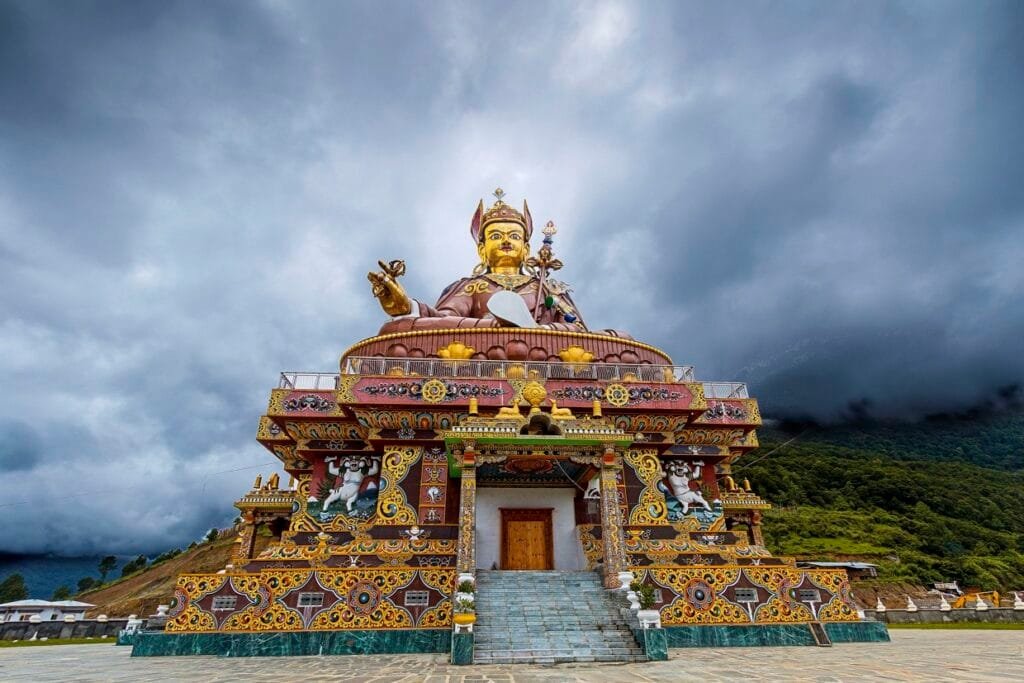Padmasambhava, also known as Guru Rinpoche, is a central figure in Tibetan Buddhism, revered for his pivotal role in introducing Buddhism to Tibet during the 8th century. His life story intertwines historical facts with spiritual legends, shaping the cultural and religious fabric of Tibet. From his miraculous birth to his legendary journey to Tibet, Padmasambhava’s influence has endured for centuries.
The Early Life of Padmasambhava: From Swat Valley to Tibet
Padmasambhava’s origins are as mysterious as his life. He is said to have been born in the Swat Valley, in what is now Pakistan, or possibly in the Uddiyana region. Legends speak of his miraculous birth on a lotus flower, which gave him the name “Padmasambhava,” meaning “Lotus-Born.” Even before his famed journey to Tibet, Padmasambhava was a respected master of tantric Buddhist practices in India.
His path to Tibet began when King Trisong Detsen, the ruler of Tibet, faced difficulties in establishing Buddhism as the state religion. The construction of the Samye Monastery, the first Buddhist monastery in Tibet, was hindered by local deities and spirits opposed to the new faith. The king, recognizing Padmasambhava’s spiritual power and ability to subdue demonic forces, extended an invitation to the master, setting the stage for one of the most significant journeys in Tibetan history.
The Spiritual Journey to Tibet
Padmasambhava’s journey to Tibet was not merely physical; it was a profound spiritual mission. While the exact route he took remains uncertain, he likely traversed the challenging Himalayan terrain, entering Tibet from the west or southwest. Along the way, Padmasambhava is said to have encountered local spirits and deities, converting them into protectors of the Buddhist Dharma. These legendary encounters are a recurring theme in Tibetan Buddhist teachings, illustrating his role as both a spiritual leader and a shamanic figure.
Upon reaching Tibet, Padmasambhava employed his tantric abilities to subdue the hostile forces that were obstructing the construction of Samye Monastery. By overcoming these spiritual challenges, he paved the way for Buddhism to flourish in Tibet. The monastery was completed around 779 AD, becoming a cornerstone of Tibetan Buddhism.
Padmasambhava’s Contributions to Tibetan Buddhism
Padmasambhava’s influence extended far beyond the construction of Samye Monastery. He is credited with founding the Nyingma school, the oldest of the four major schools of Tibetan Buddhism. His teachings, particularly on tantric practices, laid the foundation for the Nyingma tradition, which remains a vital part of Tibetan spirituality.
In addition to his teachings, Padmasambhava is also renowned for hiding spiritual treasures, or “terma,” throughout Tibet. These treasures were concealed with the intention that future spiritual masters would discover them when the time was right, ensuring the continuity of Buddhist wisdom for generations to come.

The Mythical Legacy of Padmasambhava
The life of Padmasambhava is surrounded by myth and legend. Many stories tell of his miraculous feats, such as flying through the sky and communicating with supernatural beings. These tales reflect the deep cultural and religious significance of Padmasambhava, portraying him not only as a spiritual master but also as a figure capable of bridging the material and spiritual worlds.
His legacy is celebrated through numerous festivals and rituals, where Tibetan Buddhists honor his profound teachings and the indelible mark he left on their spiritual heritage. Padmasambhava’s role in integrating local Tibetan beliefs with Buddhist teachings helped create a unique form of Buddhism that has shaped Tibetan culture for centuries.
Conclusion: A Spiritual Conquest
Padmasambhava’s journey to Tibet was far more than a historical event—it was a spiritual conquest that transformed the religious landscape of Tibet. Through his teachings and legendary feats, he not only established Buddhism but also integrated it with the local culture, creating a spiritual foundation that endures to this day. His story continues to inspire generations of Buddhists, making him a timeless figure in Tibetan history.
By focusing on Padmasambhava’s life, his journey, and his lasting contributions to Tibetan Buddhism, this narrative not only highlights his historical significance but also presents an engaging account of his legendary spiritual conquests. His legacy is a testament to the profound impact of a single individual in shaping the spiritual identity of an entire nation.

